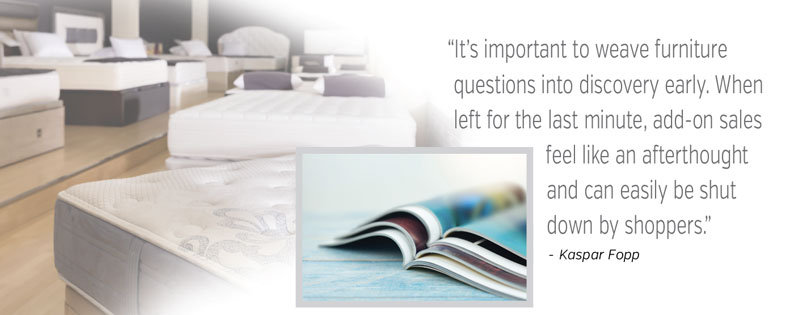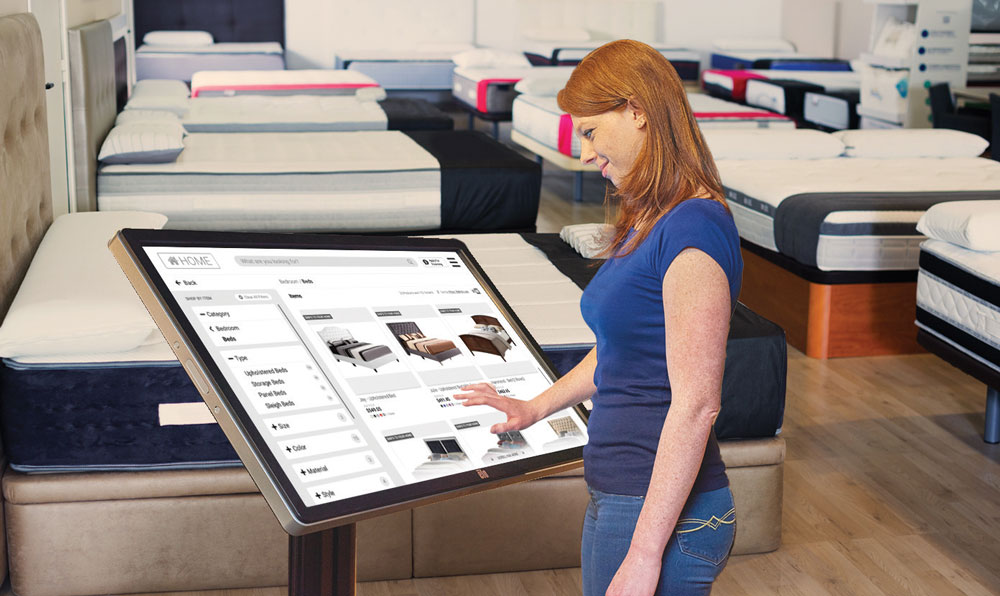by David Benbow with sidebar by Kaspar Fopp
Here is how mattress stores can increase sales by setting up catalog stations to sell furniture without
increasing floor space or overhead.
If you operate a dedicated mattress store, especially if it’s under 4,000 square feet with just enough room to
floor 35
or more SKUs and some attached headboards, you will find this article interesting.
My years of experience as a bedding consultant and retail store owner suggest that significantly increasing
floor space
and the number of SKUs in showrooms like these won’t increase sales sufficiently to cover increased overhead
costs,
including backup inventory.
So how can stores like this increase sales without increasing showroom size space?
There are proven ways to boost sales in cramped showrooms. Some of these sales-boosting methods are:
- Advertise more effectively.
- Improve the level of professionalism of your sales team.
- Better understand your competition and exploit their weaknesses.
- Enhance store appearance.
- Optimize SKU selection by replacing poor-selling SKUs.
- Add special order or drop-ship merchandise other than mattresses via catalog sales.
Each of the above topics deserves careful consideration, but this article will focus primarily on how to
increase sales
by adding special-order merchandise.
Set Up for Catalog Sales
The first order of business is to develop relationships with manufacturers and distributors that sell
merchandise to
non-stocking retailers.
Only some manufacturers will allow you to use their catalogs. Many offer exclusivity to their best customers and
will
not accept special orders from anybody else.
That being said, hundreds of manufacturers will gladly accept and fill your special orders. Your job is to find
those
willing and able to do so. It’s easier than ever before because many companies have, in recent years, welcomed
interior
design custom order business.

Finding Suppliers
One of the best ways to locate new suppliers is to attend major furniture exhibitions in High Point and Las
Vegas. Other
options include Amish shows such as the OHFM (Ohio), NIWA (Indiana), and Lancaster (Pennsylvania) shows or MAC
Expos
shows, where you can find local wholesalers that service smaller retailers.
With the exception of major manufacturers who post a praetorian guard at the entrance to prevent sightseers and
those
retailers they feel aren’t worth doing business with, most showrooms and booths will welcome you to come in and
talk
business. Be sure you already have a plan for what you want to accomplish and how that will complement what your
current
customers are looking for before you speak to potential suppliers.
As you walk around exploring the selections, it is important to remember what type of products you should check
out and
which ones you should ignore, despite their glittery, shiny-object attraction. Having an exploration plan before
you go
is especially important at the larger shows. Market brochures and catalogs are readily available online or upon
request.
Study these carefully before visiting a show to avoid wasting time.
“Bedding retailers can add $30,000 to $50,000 in additional sales per store and month. Some stores are
wildly
successful. For others, it may take weeks or months to see a sale.” - Kaspar Fopp
Interviewing Suppliers
Once you know who you want to visit, it is also a good idea to jot down a list of questions for each supplier.
Among
these are:
- Will they sell to you
- What is their minimum order?
- Get pricing and shipping costs to determine your “landed” cost.
- Find out if they have printed and online catalogs.
- Ask about typical lead times for receiving orders.
- Get warranty specifics and rules for processing warranty claims.
- Ask what other retailers they sell to in your market area.
- Get the contact information for their area rep.
- What terms do they offer?
- Ask if the rep will visit your store to give a product knowledge class.
- Find out if they deliver on their trucks or ship LTL.
- How long have they been in business?
- Where is their product manufactured?
- What makes their product special and different from the competition?
- Do they have catalogs or literature you can take home with you?
- Do they supply samples, such as swatches, color charts, etc.?
- Do they offer co-op advertising?
- Do they have an online catalog that supports fabric draping and room design software?
You may have many more questions. My point is that it makes sense to get to know prospective suppliers and
establish
relationships.
It’s probably a good idea not to get overly ambitious and interview too many new prospective suppliers. Quality
always
trumps quantity when it comes to your suppliers.
“Some mattress stores display swatches, brochures, and sample pieces in strategic spots around the store
to
invite
customer attention and queries.” —David Benbow
Setting Up a Catalog Station
Once you establish relationships with catalog-type suppliers, set up one or more comfortable, convenient catalog
or home
design stations where customers can review what’s available. Some mattress stores display swatches, brochures,
and
sample pieces in strategic spots around the store to invite customer attention and queries.
These areas should accommodate more than one customer. If multiple stations are present, they should offer
customers
privacy so they can interact with salespeople or design associates rather than each other. For more information
on this,
read the “Third Baseman” chapter in my book, “How to Win the Battle for Mattress Sales: The Bedseller’s Manual.”
Printed catalogs should be organized and up to date. Make sure that no wholesale prices are displayed.
Most suppliers offer online catalogs. Never divulge account names or passwords to customers, and never use the
catalog
station as a babysitter while you attend to other tasks. Make sure whoever works with customers can answer
customers’
questions about quality, availability, custom options and pricing. It is a major task to develop retail price
lists for
what can be a daunting array of special-order products.

Selling special orders through catalog sales is not without risks. Professional shoppers from local competitors
may be
interested in what you offer, especially if they find out they’ve lost sales to you. Controlling the sale is as
essential when selling from a catalog as selling merchandise off the floor.
Getting Customers to Look at Catalogs
Having an inviting catalog station doesn’t do much good if your customers don’t know about it. Part of your sales
training is to ensure that every salesperson is familiar with all parts of the catalog station. Remember John
Lawhon’s
five groups of knowledge? Products, policies, advertising, financing and inventory also apply to the catalog
station,
especially the product knowledge part.
Salespeople also need technical training so they can:
- Expertly use available technology to work with customers.
- Ensure security for the store and customers.
- Quickly produce accurate pricing for selected SKUs, lead times and all other relevant product, delivery and
warranty
information.
All this technical training is essential, but how do you guide them to the station?
Qualify Them!
Customers will rarely come into your store just to peruse catalogs. As you meet and greet, qualify, select, etc.,
salespeople should also, as the sale progresses, introduce the idea that your store offers a far wider array of
products
than one might think, given the small size of the store. Ask them questions such as:
- Are you looking for any other furniture for your bedroom?
- Are you looking for any new living room furniture? Dining room? Etc.?
- What’s your decorating style? Might you be looking for wall decor, lighting or other accessories?
- Are you considering adding or replacing your outdoor furniture?
Bear in mind that this does not work every time, but the benefits can be great for the small effort invested.
Don’t Mislead Customers
It is important to remember that catalog sales are unlike selling off the showroom floor. Customers may object
to buying
large-ticket items they have yet to see and touch. However, that is less of a problem than it used to be since
the
Internet has trained customers to buy without trying.
For this reason, it is imperative that you buy from suppliers you trust, and that your sales efforts always
establish
your expertise and support the confidence that your customer has in you.
Remember, special orders are almost always non-cancellable and non-returnable. You must inform customers that
selections
are not refundable unless they meet warranty guidelines. Many customers will understand this and buy anyway if
the deal
is good enough and they trust you as a retailer. For example, in the first catalog sale I made when I opened my
first
mattress store, a woman told me she needed a dining room group with at least eight chairs that couldn’t cost
more than a
certain amount. Luckily, I was able to order a group that met her requirements for delivery in less than a week.
I told
her, “I haven’t seen this product, but all the other items I’ve purchased from this company have been good
values for
the money. I’ll order it for you, but you will forfeit your deposit if you cancel. And, it cannot be returned
unless it
is a warranty issue.” She replied, “Fine, I’ll take it.” That was in 1996, and to my knowledge, she is still
serving
Thanksgiving dinner on it.
Remember the phrase “good value for the money,” especially if you haven’t seen the product being ordered.
However, have
faith in the manufacturer’s integrity.
“Never divulge account names or passwords to customers, and never use the catalog station as a
babysitter
while you
attend to other tasks.” - David Benbow.
Before Placing the Order
Here is a brief checklist to review with customers before they order.
- Make sure they understand the no-return policy, if
applicable.
- Make sure they understand lead times. Add 20% to
be safe.
- Make sure they understand that what they select might not meet expectations. Don’t oversell special orders.
It’s better
to be understated and overperform.
- Always collect at least 50% down, which is nonrefundable. You don’t want to be stuck with a canceled
product.
- On your sales ticket, stamp “Special Order” with conditions of sale and ask customers to initial their
acceptance.
Some of these conditions will kill special-order catalog sales, which is to be expected. It goes with the
territory.
However, being honest and upfront will always enhance your reputation as a trustworthy retailer.
One more thing. You’re not going to get rich from catalog sales, but if performed consistently and correctly,
it’s an
excellent way to grow sales in small-footprint stores without extra overhead.
ELECTRONIC CATALOGS
Interview with Kaspar Fopp, CEO, Wondersign
Furniture World asked Kaspar Fopp, CEO of Wondersign (wondersign.com), if the home design station solution for
mattress
retailers that David Benbow suggested in the accompanying article, can be supplemented with electronic catalogs.
“Mattress retailers,” he replied, “sometimes sell special order items not shown on their sales floors using paper
catalogs and websites. These design stations can be enhanced and sometimes replaced using electronic catalogs.
“Similar to Wondersign’s footprint in the furniture industry, we’ve learned a lot by working with mattress
retailers to
help them increase average tickets by expanding their product offerings. Our solution also allows products to be
shipped
directly from the manufacturers to consumers’ doorsteps.”
Earnings Potential: “We have anecdotal evidence that bedding retailers can add $30,000 to
$50,000 in additional sales
per store and month. Some stores are wildly successful. For others, it may take weeks or months to see a sale.
This has
to do with factors such as foot traffic, in-store signage, the sales process, the training level of RSAs (Retail
Sales
Associates), and the audience’s demographic makeup.”
Sales Training Considerations: “It’s certainly a different type of sales process that needs to
be addressed,” he added.
“With furniture, the sales process has a large aesthetic component. Mattress sales are uniquely consultative,
based on
underlying factors that must be uncovered in a thorough discovery conversation. Mattress sales associates using
electronic catalogs may struggle to find hidden home furnishings features and benefits that aren’t clearly
defined.
Furniture may be sold in kits or bundles, and quantities can be tricky to understand - for example, if a
barstool comes
in a carton of two, the pricing may be for one or both. Any good catalog platform worth its salt will clearly
list all
these features, benefits, and specs.”
Curating Furniture Products: “Adjacent categories like beds, nightstands, benches, vanities, and
other bedroom pieces
seem the most logical for mattress retailers. One category that stands out is kids’ bunk beds. Demand for those
is
cyclical and limited, so having them on the floor doesn’t make sense—not even for many full-line furniture
stores.
Here’s where an ‘extended aisle’ comes into play. Have them available when demand spikes; otherwise, don’t tie
up cash
and floor space. It makes sense to curate assortments to fit the audience. If the store is promotional,
featuring a
$6,000 sofa makes little sense and scares people off.”
Working with clients: “Shoppers are being asked to buy off a screen, Fopp said. “When items are
available in 3D, guests
can see them using their phones’ AR (augmented reality) function. It’s a good idea for retailers to work with a
dedicated in-store technology company to create a memorable and unique experience. Showing guests a
regular-looking
website doesn’t differentiate the store experience from what they see in their homes.
Challenges: “We’ve found that the biggest challenges for sleep retailers are typical
barriers to entry: Minimum order
requirements, big inventory cash requirements, huge inventory space requirements, and having to deal with
damages and
returns. Supplier-fulfilled retail is an inventory-light model that gives sleep retailers all the benefits
and none of
the risks. Selling furniture is not for everyone; however,” Fopp concluded, “any mattress retailer who
fields questions
about furniture leaves money on the table if they don’t have a furniture sales process. Especially if their
guests are
in their financing funnel and have money left to spend.”
